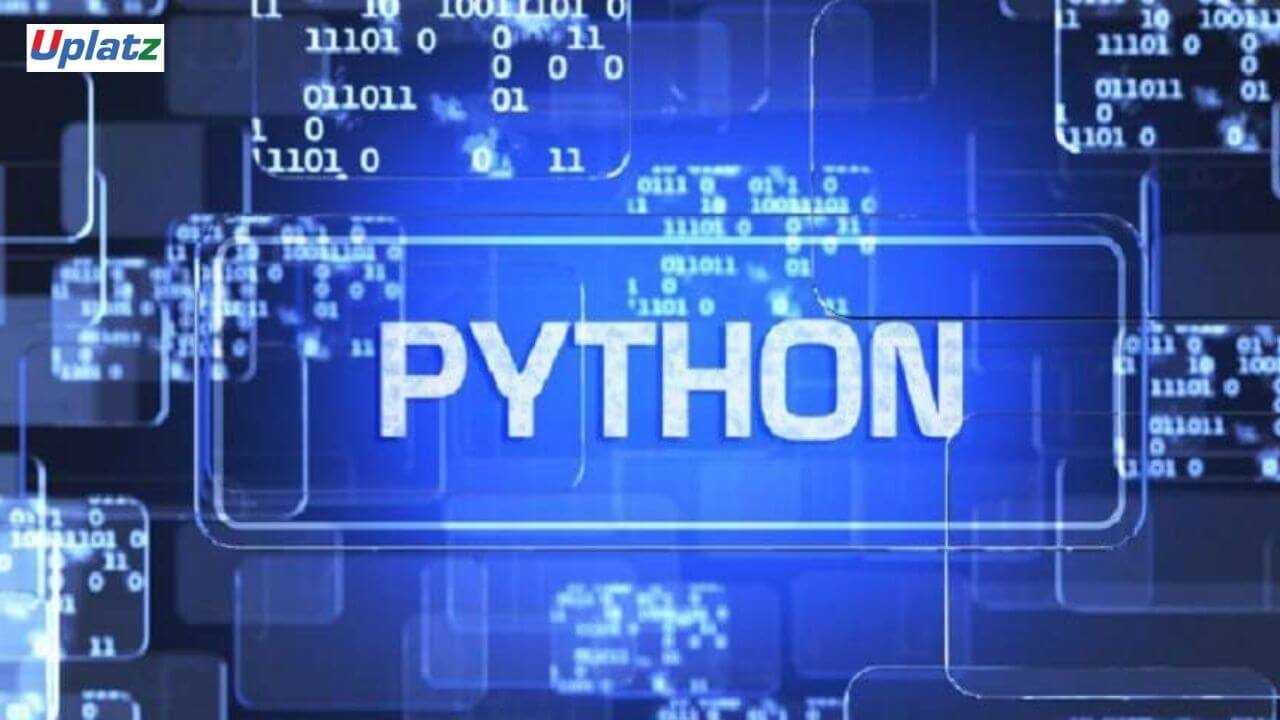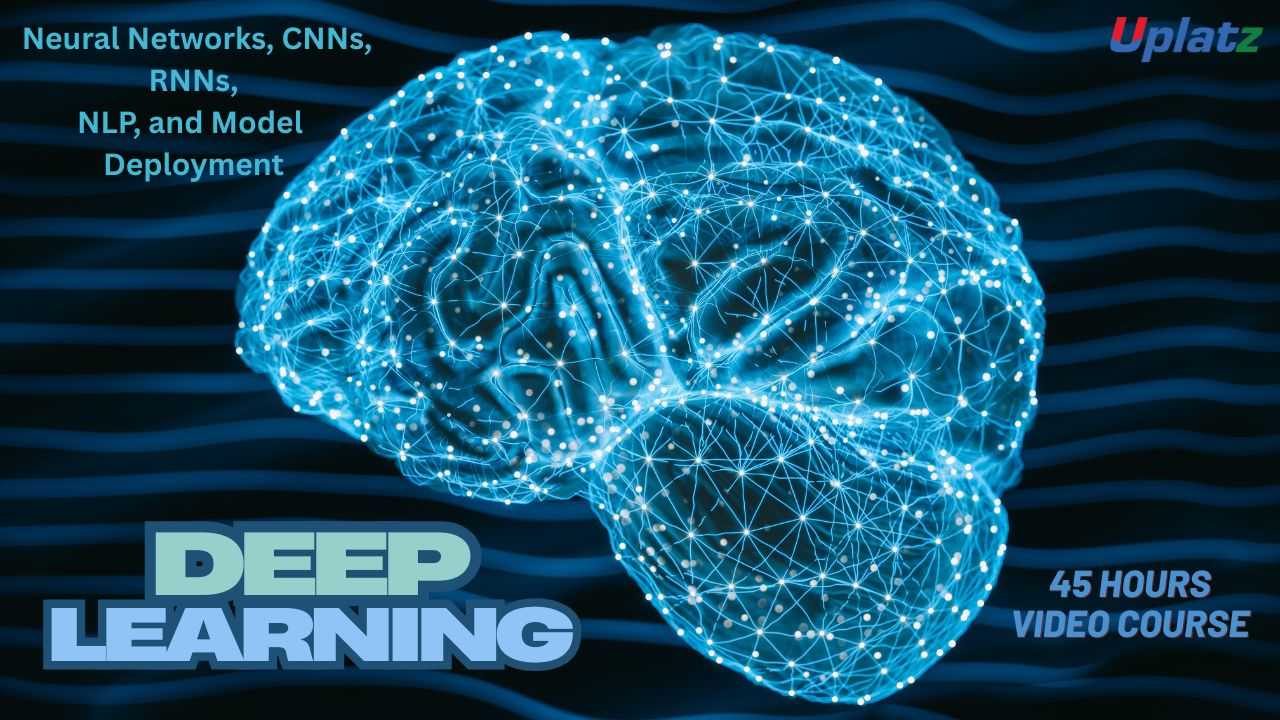Artificial Intelligence, Data Science, and Machine Learning with Python
Build Real-World AI, Data Science, Machine Learning Solutions with Python: From Data Wrangling & Visualization to Predictive Modeling, Deep Learning.Preview Artificial Intelligence, Data Science, and Machine Learning with Python course
Price Match Guarantee Full Lifetime Access Access on any Device Technical Support Secure Checkout Course Completion Certificate 95% Started a new career
BUY THIS COURSE (
95% Started a new career
BUY THIS COURSE (GBP 12 GBP 29 )-
 89% Got a pay increase and promotion
89% Got a pay increase and promotion
Students also bought -
-

- Python Programming (basic to advanced)
- 30 Hours
- GBP 12
- 2465 Learners
-

- Career Accelerator - Head of Data, Analytics, and Machine Learning
- 200 Hours
- GBP 32
- 650 Learners
-

- Deep Learning: Neural Networks, CNNs, RNNs, NLP, and Deployment
- 45 Hours
- GBP 12
- 4957 Learners

Artificial Intelligence, Data Science & Machine Learning with Python | Self-Paced Online Course
Unlock your potential and advance your career in the cutting-edge domains of Artificial Intelligence (AI), Data Science, and Machine Learning (ML) through this expertly curated self-paced online course. Designed with a strong focus on Python—the most widely used language in data-driven technologies—this course is your gateway to mastering the skills that power the future of intelligent systems and data-driven decision-making.
This course is more than just an academic introduction; it's a practical, hands-on journey into the real-world applications of AI, ML, and Data Science using Python. Whether you're aiming to become a data scientist, machine learning engineer, AI developer, or a technical analyst, this course is crafted to provide a strong and adaptable foundation. It delivers not only theoretical understanding but also applicable coding skills and problem-solving techniques that are in high demand across industries.
Python serves as the backbone of this course, and for good reason. It has become the go-to programming language for AI and Data Science due to its simplicity, readability, and expansive ecosystem of libraries and frameworks. In this course, you'll work with essential Python libraries such as:
- NumPy and Pandas for data manipulation and analysis
- Matplotlib and Seaborn for data visualization
- Scikit-learn for machine learning algorithms
- TensorFlow and PyTorch for deep learning and neural networks
- NLTK and spaCy for natural language processing
From the ground up, you'll learn how to import and clean datasets, perform exploratory data analysis, visualize insights, and build predictive models. The course covers both supervised and unsupervised learning techniques, enabling you to solve classification, regression, clustering, and dimensionality reduction problems with confidence. As you progress, you’ll also explore advanced topics such as deep learning, reinforcement learning, and AI-driven automation systems.
What truly sets this course apart is its project-based structure. Real-world projects and coding exercises accompany each module to reinforce the concepts and enhance practical understanding. These projects mirror actual industry scenarios, giving you a chance to apply your knowledge in tasks such as fraud detection, sentiment analysis, image classification, recommendation systems, and predictive analytics. By the end of the course, you'll have a portfolio of completed projects that demonstrate your ability to solve real business challenges using AI and data science techniques.
How to Use This Course Effectively
This self-paced course is designed for maximum flexibility, allowing you to learn at your own speed while still gaining comprehensive, industry-relevant skills. Here's how you can make the most out of this learning experience:
- Start with the Basics
If you're new to Python or programming, begin with the foundational modules that introduce Python syntax, variables, data types, and control flow. These lessons will build the groundwork for more advanced topics. - Follow a Structured Path
Though the course is self-paced, it follows a logical progression—from basic data handling to complex machine learning and AI models. It’s highly recommended to complete the modules in order to avoid missing key concepts that build upon one another. - Engage with the Videos and Hands-On Exercises
Each video tutorial is complemented by interactive coding labs and practical exercises. Try to code along with the instructor and attempt each problem on your own to reinforce your learning. Rewatch sections as needed to clarify doubts. - Work on the Projects Seriously
Treat the real-world projects as mini-internships. They are designed to simulate professional tasks and are essential for applying theoretical knowledge. Document your work thoroughly, as these can serve as portfolio pieces for future job applications or interviews. - Use External Resources for Deeper Learning
While the course content is comprehensive, you may benefit from supplemental materials such as documentation, research papers, GitHub repositories, and forums like Stack Overflow. Don’t hesitate to explore these as you dive deeper into complex topics. - Practice Regularly and Revisit Concepts
Machine Learning and AI are not just about understanding theory—they require continuous practice. Regularly revisit earlier modules to keep your skills sharp. Practice coding on your own and try to replicate models using different datasets. - Test Your Knowledge Frequently
Use the built-in quizzes and assessments to test your understanding of each topic. These will help reinforce what you’ve learned and identify areas that may need more focus. - Stay Curious and Explore
AI and Data Science are evolving fields. After completing the course, continue experimenting with new datasets, trying out different algorithms, and exploring new tools and libraries. The knowledge you gain here will be your stepping stone into more advanced studies or professional roles. - Build a Network and Share Your Work
Share your completed projects on GitHub, LinkedIn, or Kaggle. Join online communities of learners and professionals. Networking not only enhances your learning but also opens doors to collaboration and career opportunities.
Who Should Take This Course?
This course is ideal for:
- Beginners who want to enter the fields of Data Science, AI, or ML
- Working professionals looking to pivot into tech or upskill for better opportunities
- Engineers and developers aiming to integrate AI features into their applications
- Analysts and statisticians seeking to enhance their technical and programming proficiency
By the end of this course, you will have the skills, confidence, and hands-on experience needed to tackle real-world AI and data science problems using Python. Whether your goal is academic enrichment, personal development, or professional advancement, this course empowers you to take the next big step in your tech journey.
Course/Topic 1 - Course access through Google Drive
-
Google Drive
-
Google Drive
By the end of this course, learners will be able to:
- Understand the fundamentals of AI, data science, and machine learning.
- Work with Python libraries such as NumPy, Pandas, Matplotlib, Seaborn, Scikit-learn, TensorFlow, and Keras.
- Perform data preprocessing, data cleaning, and exploratory data analysis (EDA).
- Build and evaluate machine learning models including regression, classification, and clustering.
- Implement deep learning models using neural networks and TensorFlow/Keras.
Apply Natural Language Processing (NLP) for text classification, sentiment analysis, and chatbot development. - Develop AI projects such as image recognition, recommendation systems, and prediction engines.
- Work on real-world datasets from healthcare, finance, e-commerce, and more.
- Understand model deployment, API creation with Flask, and model performance monitoring.
- Prepare for roles in data science, AI development, and machine learning engineering.
Course Curriculum: Artificial Intelligence, Data Science & Machine Learning with Python
Master the essential skills in AI, Data Science, and Machine Learning with hands-on Python training. This comprehensive course covers everything from Python programming to advanced ML algorithms, ensuring you gain practical expertise for real-world applications.
Course Modules
1. Introduction to AI, Data Science & Python Setup
- Overview of AI and Data Science
- Key components and industry applications
- Setting up Python with Anaconda, Jupyter Notebook, and Spyder IDE
2. Python Programming Fundamentals
- Variables, operators, and data structures (lists, tuples, dictionaries)
- Control flow (loops, conditionals, functions)
- Lambda functions, recursion, and error handling
3. Data Importing & Cleaning
- Importing data from CSV, Excel, SQL, APIs, and web scraping
- Handling missing values, outliers, and inconsistencies
- Data manipulation with NumPy & Pandas
4. Exploratory Data Analysis (EDA) & Statistics
- Descriptive statistics (mean, median, variance, skewness)
- Univariate, bivariate, and multivariate analysis
- Probability distributions (Normal, Binomial, Poisson)
5. Data Visualization
- Creating plots with Matplotlib & Seaborn (histograms, scatter plots, box plots)
- Interactive visualizations with Plotly
- Storytelling with data
6. Statistical Inference & Hypothesis Testing
- Confidence intervals, p-values, and Z/T-tests
- ANOVA, Chi-square tests, correlation analysis
- Bayesian probability & sampling techniques
7. Machine Learning & Predictive Modeling
Supervised Learning:
- Regression (Linear, Polynomial, Logistic)
- Classification (Decision Trees, SVM, KNN, Naive Bayes)
Unsupervised Learning:
- Clustering (K-Means, Hierarchical, DBSCAN)
- Dimensionality Reduction (PCA, LDA)
- Ensemble Methods (Random Forest, Boosting, Bagging)
8. Capstone Project
- End-to-end real-world project applying all concepts
- Problem-solving with AI/ML pipelines
- Model deployment insights
Upon successfully completing the Artificial Intelligence, Data Science, and Machine Learning with Python course, learners will receive a Course Completion Certificate from Uplatz, validating their expertise in building AI and ML models using Python.
This certificate strengthens your professional profile and supports career growth in data science, AI engineering, machine learning, and advanced analytics.
With the demand for AI and data science professionals growing rapidly, completing this course will position you for roles in top organizations across industries like finance, healthcare, e-commerce, and technology. Career paths include:
- Data Scientist
- Machine Learning Engineer
- AI Developer
- Data Analyst
- Python Developer
- Deep Learning Specialist
- Business Intelligence Analyst
Professionals with strong Python-based AI and data skills are essential to companies aiming to build smart, data-driven solutions.
1. What is the difference between AI, machine learning, and data science?
AI focuses on creating intelligent systems, ML is a subset that involves algorithms learning from data, and data science includes data analysis, visualization, and model building.
2. Why is Python used in AI and data science?
Python offers simplicity, readability, and powerful libraries like Pandas, NumPy, and TensorFlow, making it ideal for AI, ML, and data analysis tasks.
3. What is supervised vs. unsupervised learning?
Supervised learning uses labeled data to train models (e.g., regression, classification), while unsupervised learning finds hidden patterns in unlabeled data (e.g., clustering).
4. What is overfitting and how can it be prevented?Overfitting occurs when a model performs well on training data but poorly on new data. It can be reduced using cross-validation, regularization, or pruning.
5. What is a confusion matrix?
It’s a table that evaluates classification models by showing the true vs. predicted values across categories, helping measure accuracy, precision, recall, and F1 score.
6. How does a neural network work?
Neural networks simulate the human brain, with layers of nodes (neurons) connected by weights that adjust during training to recognize complex patterns.
7. What is TensorFlow used for?
TensorFlow is an open-source framework used to build and deploy deep learning and machine learning models efficiently.
8. What are the steps in a data science project?
Data collection, cleaning, exploration, feature engineering, model building, evaluation, and deployment.
9. What is cross-validation?
A technique for assessing model performance by dividing the data into multiple training and testing sets to ensure generalization.
10. How do you deploy a machine learning model?
You can deploy using Flask or FastAPI to expose the model via an API, or use cloud platforms like AWS SageMaker, Azure ML, or GCP AI Platform.









